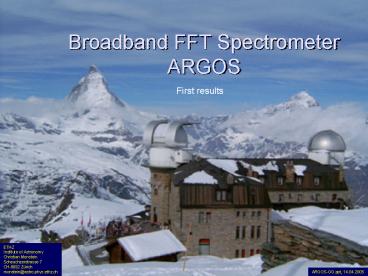Broadband FFT Spectrometer ARGOS - PowerPoint PPT Presentation
1 / 40
Title:
Broadband FFT Spectrometer ARGOS
Description:
Broadband FFT Spectrometer. ARGOS. First results. ETHZ. Institute of Astronomy. Christian Monstein ... FFT spectrometer 30'000 Euro. Some statistics to ... – PowerPoint PPT presentation
Number of Views:108
Avg rating:3.0/5.0
Title: Broadband FFT Spectrometer ARGOS
1
Broadband FFT Spectrometer ARGOS
First results
ETHZ Institute of Astronomy Christian
Monstein Scheuchzerstrasse 7 CH-8092
Zürich monstein_at_astro.phys.ethz.ch
ARGOS-GG.ppt, 14.04.2005
2
Content
- Specifications, block diagrams
- FPGA, VHDL, resource table
- Schedule, cost, additional information
- KOSMA block diagram, measurement methods
- Gornergrat impressions
- Measurements in the laboratory
- Spectrum results
- Software, GUI
- RF-overview Gornergrat 3100m, Bleien 420m and
Diavolezza 3000m - Conclusions
FPGA Field Programmable Gata Array VHDL Very
High Speed Integrated Circuit Description
Language KOSMA Kölner Observatorium für
SubMillimeter Astronomie GUI Graphical User
Interface RF Radio Frequency
3
Specifications
PCI Peripheral Component Interconnect (local
bus standard) AD Analog Digital Converter
4
Block diagram AC240
Opt. DRAM
Opt. SRAM
Digital processing Unit FPGA Xilinx Virtex-2 pro
XC2VP70
Additional digital l/O from/to telescope Analog
output
2 x 128 bits
?t0.5nsec
Preamp 1GHz
ADC 1 1Gs/s 8 bit
Demux 1 8 bits x 16
Ch1
Cross Point Switch
Preamp 1GHz
ADC 2 1Gs/s 8 bit
Demux 2 8 bits x 16
Ch2
Trigger
Time Base
Controller
PCI Interface
PCI Bus
Ext trigger
Ext clock
5
PCB AC240 with FPGA
6
Block diagram AC240
1 Gs/s complex
16 k FFT Pipeline complex input complex output
Post Processing Unit
even
S
2 Gs/s real
Redundant data
j
odd
1 Gs/s complex
1 Gs/s complex
2 x 1 Gs/s real
7
32K FFT with 2Gs/sec throughput
125MHz
125MHz
8
Overview of AC240 FDK core
9
VHDL design with MENTOR tool
Design Entry HDL Desinger 2004.1a Simulation
ModelSim 5.8c Synthese Precision
RTL 2004.a1 Place Route Xilinx ISE 6.2i
10
Utilization FPGA resources
- No use of internal Power-PC (gray area)
foreseen - Purple input structure and programmable window
- Yellow pipeline 1, green pipeline 2
- Violet output structure
- horizontal structure Block-RAM and multipliers
11
Xilinx FPGA Virtex II XC2VP70-6 resources
- Slices 29247 88.4
- Flip Flops 38272 57.2
- Block-RAM 300 91.5
- Multiplier 192 58.5
- fmax 138 MHz (required 125 MHz)
12
Schedule
- Planned In fact
- Start of KTI-project 2003-11-01 2004-11-01
- Decision system architecture 2004-03-18 2004-03
-18 - Preliminary tests of 1st implementation
2004-08-30 2004-09-30 - System ready for Radio Astronomy
2004-12-20 2005-03-18 - Scientific analysis, fist results
2005-03-07 2005-04-05 - End of project, closing report to KTI
2005-04-02 2005-05-31
13
Costs
Acqiris sampler 2Gs/s AC240 20000 Euro Option
FFT (Bitfile) 4000 Euro PCI-interface IC414
1400 Euro Blanking panel XB200 100
Euro 3-slot crate CC103 2500 Euro Driver
(Win/Linux) free of charge
0 Euro Standard-PC with one free PCI-slot
2000 Euro FFT spectrometer 30000
Euro Some statistics to remember. 1,8 Euro
per FFT-channel or 33KHz bandwidth for every
single Euro
Actual prices to be negotiated with Acqiris!
14
Additional information
- Project management tests ETH Zurich
- Prof. A. O. Benz
- - Chr. Monstein
- - Hansueli Meyer
- Algorithms FHS (Fachhochschule Solothurn)
- - Bruno Stuber
- VHDL design ZMA (Zentrum für Mikroelektronik
Aargau) - Prof. K. Schenk
- D. Zardet
- Industry Acqiris company Geneva
- - Dr. V. Hungerbühler et. al.
Additional information http//www.astro.phys.eth
z.ch/instrument/argos/argos_nf.html http//www.acq
iris.com
15
Block diagram KOSMA
AOS LRS 1000MHz/1450
KOSMA DSP
KOSMA control
Positioning unit
AOS MRS 300MHz/1800
Receivers 200900GHz
AOS HRS 59MHz/2048
Local oscillator unit
IF unit
ETH-FFT 1GHz/16384
Digital I/O
-Data ready -Wobbler control
IF 350MHz150MHz
PC Win XP Argos,FTP, VNC
Intranet
To Internet
Laptop LINUX IDL
PC Win XP Office, VNC
Printers
16
KOSMA measurement methods
17
KOSMA 3m-parabola
18
KOSMA Control room
Ilona Miller
19
KOSMA clock generation
20
ARGOS, IF-units AOS
21
Allan time hot noise source
Data 3.6 GByte in total, (extraction of
Saturday, 02.04.2005. Used for analysis 0815 -
2100) FPGA 52.8C 0.2K Place Library
SEC Range 50mVpp
sec
22
Channel test 10MHz comb
23
Receiver temperature 230GHz
Birdies lt 200MHz and gt 500MHz are out of KOSMA-IF
(red shaded area)!
24
DR21K 12CO 2?1
Some single spectra 15sec each ? source -
reference ? reference - source
25
DR21K 12CO 2?1
230.537994GHz
Ti 179sec BW 47KHz
Ti 90sec BW 61KHz
26
DR21K 12CO 3?2
Channel width 60KHz Ti 200sec
Channel width 560KHz Ti 400sec
27
ORION A 12CO 2?1
Channel width 240KHz Ti 10sec
Channel width 560KHz Ti 20sec
28
AFGL 2591 12CO 3?2
Channel width 240KHz Ti 160sec
Channel width 560KHz Ti 320sec
29
IRC 10216 12CO 2?1 Observation 3h
SNR with BW240KHz, Ti3420sec
Ta with BW560KHz, Ti5700sec
30
Sun in absorption 12CO 3?2
31
12CO 2?1 Line
32
Dual beam switched mode
Tamax 1Kelvin
33
Frequency switching 12CO 2?1
Fo 230537.994MHz 10.5MHz
34
Ozone in the atmosphere
AOS saturated
35
ARGOS-GUI Windows XP
36
ARGOS on-line graphics
Sky noise
Zero noise
The ADC-range has to be adjusted such that peak
amplitudes dont strike maximum values but, the
ADC should be set to maximum gain while
observing a hot load.
Comb noise
37
Base band overviews DC-1GHz
38
Time- frequency domain Gornergrat 3100m asl
10sec base band dc-1GHz
30sec IF (230GHz - RX)
39
Time- frequency domain duringVP Diavolezza
3000m asl
Radar pulse 1028...1030MHz using an L-band down
converter
Echo of ionosphere sonder 1630Mhz while doing
Jupiter/Io observations.
40
Conclusions































